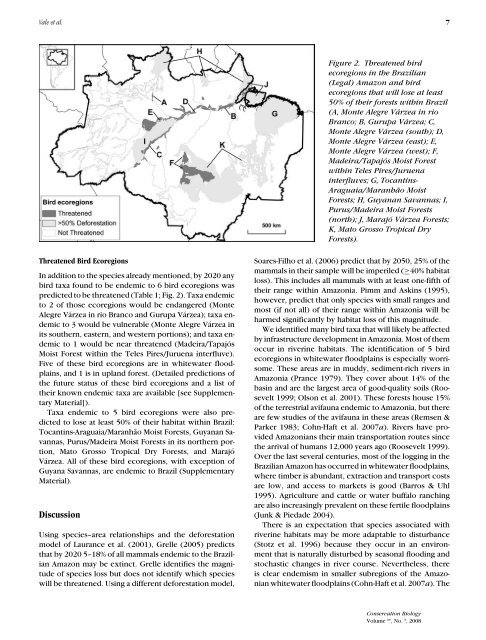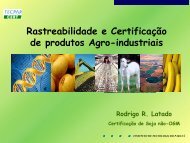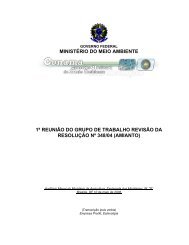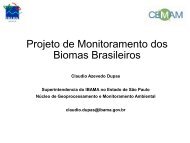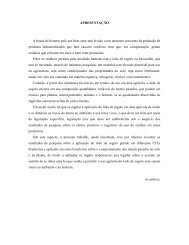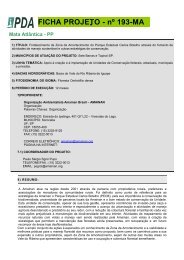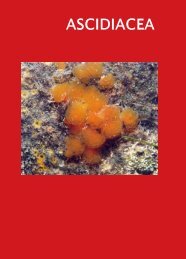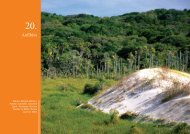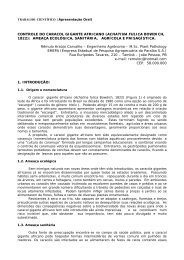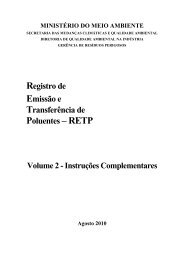Effects of Future Infrastructure Development on Threat Status and ...
Effects of Future Infrastructure Development on Threat Status and ...
Effects of Future Infrastructure Development on Threat Status and ...
You also want an ePaper? Increase the reach of your titles
YUMPU automatically turns print PDFs into web optimized ePapers that Google loves.
Vale et al. 7<br />
<strong>Threat</strong>ened Bird Ecoregi<strong>on</strong>s<br />
In additi<strong>on</strong> to the species already menti<strong>on</strong>ed, by 2020 any<br />
bird taxa found to be endemic to 6 bird ecoregi<strong>on</strong>s was<br />
predicted to be threatened (Table 1; Fig. 2). Taxa endemic<br />
to 2 <str<strong>on</strong>g>of</str<strong>on</strong>g> those ecoregi<strong>on</strong>s would be endangered (M<strong>on</strong>te<br />
Alegre Várzea in rio Branco <strong>and</strong> Gurupa Várzea); taxa endemic<br />
to 3 would be vulnerable (M<strong>on</strong>te Alegre Várzea in<br />
its southern, eastern, <strong>and</strong> western porti<strong>on</strong>s); <strong>and</strong> taxa endemic<br />
to 1 would be near threatened (Madeira/Tapajós<br />
Moist Forest within the Teles Pires/Juruena interfluve).<br />
Five <str<strong>on</strong>g>of</str<strong>on</strong>g> these bird ecoregi<strong>on</strong>s are in whitewater floodplains,<br />
<strong>and</strong> 1 is in upl<strong>and</strong> forest. (Detailed predicti<strong>on</strong>s <str<strong>on</strong>g>of</str<strong>on</strong>g><br />
the future status <str<strong>on</strong>g>of</str<strong>on</strong>g> these bird ecoregi<strong>on</strong>s <strong>and</strong> a list <str<strong>on</strong>g>of</str<strong>on</strong>g><br />
their known endemic taxa are available [see Supplementary<br />
Material]).<br />
Taxa endemic to 5 bird ecoregi<strong>on</strong>s were also predicted<br />
to lose at least 50% <str<strong>on</strong>g>of</str<strong>on</strong>g> their habitat within Brazil:<br />
Tocantins-Araguaia/Maranhão Moist Forests, Guyanan Savannas,<br />
Purus/Madeira Moist Forests in its northern porti<strong>on</strong>,<br />
Mato Grosso Tropical Dry Forests, <strong>and</strong> Marajó<br />
Várzea. All <str<strong>on</strong>g>of</str<strong>on</strong>g> these bird ecoregi<strong>on</strong>s, with excepti<strong>on</strong> <str<strong>on</strong>g>of</str<strong>on</strong>g><br />
Guyana Savannas, are endemic to Brazil (Supplementary<br />
Material).<br />
Discussi<strong>on</strong><br />
Using species–area relati<strong>on</strong>ships <strong>and</strong> the deforestati<strong>on</strong><br />
model <str<strong>on</strong>g>of</str<strong>on</strong>g> Laurance et al. (2001), Grelle (2005) predicts<br />
that by 2020 5–18% <str<strong>on</strong>g>of</str<strong>on</strong>g> all mammals endemic to the Brazilian<br />
Amaz<strong>on</strong> may be extinct. Grelle identifies the magnitude<br />
<str<strong>on</strong>g>of</str<strong>on</strong>g> species loss but does not identify which species<br />
will be threatened. Using a different deforestati<strong>on</strong> model,<br />
Figure 2. <strong>Threat</strong>ened bird<br />
ecoregi<strong>on</strong>s in the Brazilian<br />
(Legal) Amaz<strong>on</strong> <strong>and</strong> bird<br />
ecoregi<strong>on</strong>s that will lose at least<br />
50% <str<strong>on</strong>g>of</str<strong>on</strong>g> their forests within Brazil<br />
(A, M<strong>on</strong>te Alegre Várzea in rio<br />
Branco; B, Gurupa Várzea; C,<br />
M<strong>on</strong>te Alegre Várzea (south); D,<br />
M<strong>on</strong>te Alegre Várzea (east); E,<br />
M<strong>on</strong>te Alegre Várzea (west); F,<br />
Madeira/Tapajós Moist Forest<br />
within Teles Pires/Juruena<br />
interfluves; G, Tocantins-<br />
Araguaia/Maranhão Moist<br />
Forests; H, Guyanan Savannas; I,<br />
Purus/Madeira Moist Forests<br />
(north); J, Marajó Várzea Forests;<br />
K, Mato Grosso Tropical Dry<br />
Forests).<br />
Soares-Filho et al. (2006) predict that by 2050, 25% <str<strong>on</strong>g>of</str<strong>on</strong>g> the<br />
mammals in their sample will be imperiled (≥40% habitat<br />
loss). This includes all mammals with at least <strong>on</strong>e-fifth <str<strong>on</strong>g>of</str<strong>on</strong>g><br />
their range within Amaz<strong>on</strong>ia. Pimm <strong>and</strong> Askins (1995),<br />
however, predict that <strong>on</strong>ly species with small ranges <strong>and</strong><br />
most (if not all) <str<strong>on</strong>g>of</str<strong>on</strong>g> their range within Amaz<strong>on</strong>ia will be<br />
harmed significantly by habitat loss <str<strong>on</strong>g>of</str<strong>on</strong>g> this magnitude.<br />
We identified many bird taxa that will likely be affected<br />
by infrastructure development in Amaz<strong>on</strong>ia. Most <str<strong>on</strong>g>of</str<strong>on</strong>g> them<br />
occur in riverine habitats. The identificati<strong>on</strong> <str<strong>on</strong>g>of</str<strong>on</strong>g> 5 bird<br />
ecoregi<strong>on</strong>s in whitewater floodplains is especially worrisome.<br />
These areas are in muddy, sediment-rich rivers in<br />
Amaz<strong>on</strong>ia (Prance 1979). They cover about 14% <str<strong>on</strong>g>of</str<strong>on</strong>g> the<br />
basin <strong>and</strong> are the largest area <str<strong>on</strong>g>of</str<strong>on</strong>g> good-quality soils (Roosevelt<br />
1999; Ols<strong>on</strong> et al. 2001). These forests house 15%<br />
<str<strong>on</strong>g>of</str<strong>on</strong>g> the terrestrial avifauna endemic to Amaz<strong>on</strong>ia, but there<br />
are few studies <str<strong>on</strong>g>of</str<strong>on</strong>g> the avifauna in these areas (Remsen &<br />
Parker 1983; Cohn-Haft et al. 2007a). Rivers have provided<br />
Amaz<strong>on</strong>ians their main transportati<strong>on</strong> routes since<br />
the arrival <str<strong>on</strong>g>of</str<strong>on</strong>g> humans 12,000 years ago (Roosevelt 1999).<br />
Over the last several centuries, most <str<strong>on</strong>g>of</str<strong>on</strong>g> the logging in the<br />
Brazilian Amaz<strong>on</strong> has occurred in whitewater floodplains,<br />
where timber is abundant, extracti<strong>on</strong> <strong>and</strong> transport costs<br />
are low, <strong>and</strong> access to markets is good (Barros & Uhl<br />
1995). Agriculture <strong>and</strong> cattle or water buffalo ranching<br />
are also increasingly prevalent <strong>on</strong> these fertile floodplains<br />
(Junk & Piedade 2004).<br />
There is an expectati<strong>on</strong> that species associated with<br />
riverine habitats may be more adaptable to disturbance<br />
(Stotz et al. 1996) because they occur in an envir<strong>on</strong>ment<br />
that is naturally disturbed by seas<strong>on</strong>al flooding <strong>and</strong><br />
stochastic changes in river course. Nevertheless, there<br />
is clear endemism in smaller subregi<strong>on</strong>s <str<strong>on</strong>g>of</str<strong>on</strong>g> the Amaz<strong>on</strong>ian<br />
whitewater floodplains (Cohn-Haft et al. 2007a). The<br />
C<strong>on</strong>servati<strong>on</strong> Biology<br />
Volume **, No. *, 2008


